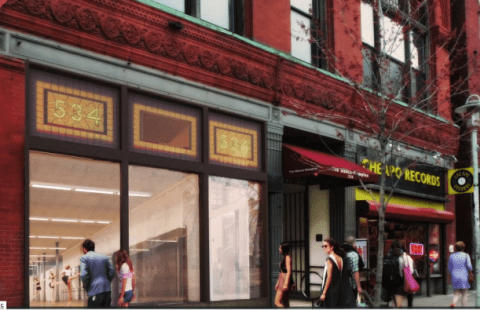What were the specific goals of this creative economy project? Describe the community development challenge or opportunity that your project was designed to address:
Early in a new ED's tenure at The Dance Complex, it became apparent that a much needed refinancing of the building would not occur due to the tenant in one of its first floor storefronts, namely a adult themed sex toy shop. A deal was struck to let the business go, and pros and cons of what to do with the space became a back-doored goal: how to take a forced-hand and make it a positive. The swiftly re-imagined space became a project dedicated to creating a portal of dance, making access a key question, a key goal. Challenged by the time frame and forced hand, and realizing opportunity of ultimately more mission-driven and economically viable space, the space is a result of multiple and frequent paths of action, triumphs, frustrations and ultimate success.
If the goals change over time, please describe how:
Once decided that a studio would be housed, the goals remained the same. Rather than change, present on a daily basis were impediments threatening the projects completion.
Who was involved in this project and what did they do? (be sure to include the partners from outside of the creative sector and how local voices were included):
Key was support from the Mass Cultural Council's capital improvement monies; City of Cambridge facade reimbursement program; the city's and state's mandate for ADA standard space; the Cambridge Historical Commission and its recommendation to the state Historical Board; the Dance Complex's savings; pro bono advice from acoustic firms; discounted architect's fees; late in the process, the Barr Foundation supported us with an overall grant for many things, with a 135k appropriation for finishing the renovation.
How does this project relate to a larger community development strategy?
The need to move quickly, due to financial need, forced a newly in place ED and refreshed board with the challenge of little planning time. The outcome, though, of this streamlined process actually became the metaphor for our future: a portal of dance, where dance arts are no longer sequestered in a potentially daunting refuge, but now the dance is allowed to be a visceral experience to members of the community through witnessing it. Planning has now been unleashed for how The Dance Complex can extend beyond its physical parameters on to the sidewalk (Arts Patio) and beyond. The questions of Dance Access are now more fully a part of our dialogue and plans for future: immediately Studio 7 allows those with mobility issues into our world; and we now are realizing how Access becomes a multi-dimensional defining concept for anyone who feels a barrier to dance or movement or walking through our doors.
What projects or places, if any, inspired your approach to this creative economy project?
Early pioneer of dance studios on street level included Miami Ballet's former studios in Miami Beach, off Collins Avenue. We pulled from the histories of ODC, whose second floor studios housed street level activity; and Ailey's studios in NY, with dance intentionally visible to passersby become architectural models. Other inspirations include community engaging art spaces in Washington DC, including Dance Exchange and Dance Place.
